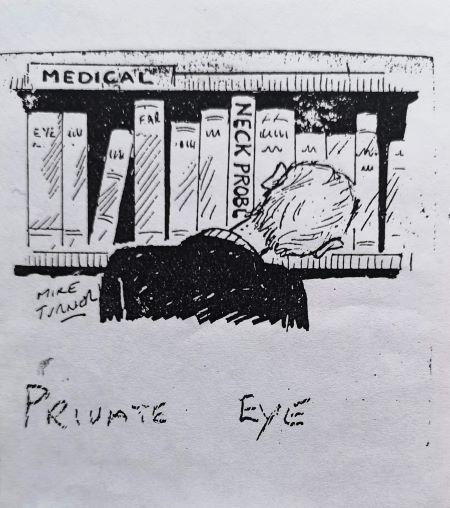Torticollis – Wryneck is a form of Cervical Dystonia
Torticollis is a condition where a person’s head and neck are constantly twisted by spasms in their neck muscles. These contract down towards one side all the time, often with abnormal rigidity. This old Private Eye cartoon says it all! Torticollis may develop gradually or suddenly and babies may be born with Congenital Muscular Torticollis.

Acute Torticollis or Wryneck
This is the term given when the condition arrives suddenly. For instance a person may wake up to find they slept in a distorted position and have such a stiff neck that they cannot move their head from side to side. This problem often resolves itself fairly quickly. But a wise person would ask themselves what they might have been doing to bring it on and then find a way of avoiding it happening again.
Diagnosis
When severe, torticollis may be associated with damage to the cervical vertebrae and discs. Diagnosis is essential when there are symptoms such as chronic neck pain with numbness in the hands and arms. This numbness not only poses a threat to many careers but indicates an underlying problem where the nerves are being irritated. The cause needs to be known, to check for a prolapsed disc and to rule out illnesses such as meningitis, particularly if the person has a fever.
Causes and Development of Neck Pain
Torticollis can be caused by accidents, injuries, tissue scarring and shrinkage. It can also be brought about by mental states such as anxiety and habitual patterns of poor body use, as in the image above.
Poor posture and long-term mis-use of the body, that disturbs the natural muscle balance in the neck, can lead to the gradual development of torticollis. Unfortunately, many children hunch over school books, holding the pen in a contracted, twisted manner whilst writing. This is a habit they often take into adulthood and then gradually develop neck pain – unless they learn to let go of the habit. Also babies whose heads are left lolling down to one side as they sleep in pushchairs, must be vulnerable to wryneck developing. Over time the neck muscles can get used to being contracted in this way and they become fixed so that torticollis can develop.
There are also work situations which require a person to incline their head and body in one direction constantly. Radiologists for instance, or violinists, often resort to pulling their heads down to one side quite tensely in order to work or hold the violin in place. Dentists often lean down over patients at an angle and a twist – for hours on end all their working lives! If such activities are performed without looking after the head-neck-back relationship and general body use, then problems such as torticollis and neck pain are likely to develop.
Treatment
In extreme cases, botulism can be injected into the muscle to stop the spasm for a few months. Surgery to partially cut and release the contracted muscle is sometimes used as a last resort. Physiotherapy to help stretch out the muscles can be helpful.
Can the Alexander Technique help Torticollis?
Fortunately, it is possible to improve one’s body use by learning the Alexander Technique so we can avoid the habits of twisting and contracting that contribute to torticollis. Through the gentle guidance of the Alexander Teacher, it is possible to re-educate muscles so that they can relax and ease out of the neck spasm. This puts less pressure onto vulnerable discs and nerves and begins to re-establish the natural head neck back relationship.
Many violinists for instance, have been saved from constant pain which could threaten their careers, by applying the Alexander Technique to playing. They can learn to hold and play their instrument in a manner which does not cause them harm. When they learn how to maintain a freedom and resilient lengthening of their muscles, they can avoid going into spasm whilst playing.
Research into the Alexander Technique and Neck Pain
More generally, a major research study, the ATLAS Research Trial (2015) has shown that the Alexander Technique produced “clinically relevant reductions in neck pain and associated disability” for people with chronic non-specific neck pain.
http://annals.org/article.aspx?articleid=2467961
If you would like to discover how the Alexander Technique can help you with neck pain and other conditions, you can contact me to arrange an Introductory Alexander Lesson: